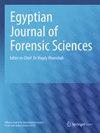Age estimation from the sternal end of left fourth rib in the Nepalese population
IF 1.3
Q3 MEDICINE, LEGAL
引用次数: 0
Abstract
Forensic anthropological examinations help in identification of unidentified human remains. This study aims to establish population-specific standards for age estimation from the sternal ends of left fourth ribs in the Nepalese population. A quantitative, observational study was conducted on 387 Nepalese deceased (106 females, 281 males) between November 2021 and March 2023. Left fourth ribs were collected, macerated and examined for the study. The variables examined included pit depth, pit shape, rim and wall configurations and rib phase. Pit depth significantly predicted age, β = 0.642, t(385) = 16.42, p < 0.001. Pit depth also explained a significant proportion of variance in age, R2 = 0.41, F(1, 385) = 269.54, p < 0.001. The age estimates from pit depth stage were 7–36 (stage 0), 7–49 (stage 1), 16–51 (stage 2), 10–58 (stage 3), 22–70 (stage 4) and 32–81 (stage 5). Age estimates for pit shape were 17–20 (stage 0), 13–48 (stage 2), 15–55 (stage 3), 24–68 (stage 4) and 39–82 (stage 5). Age estimates for rim and wall configurations were 17–20 (stage 0), 13–47 (stage 2), 17–53 (stage 3), 24–68 (stage 4) and 40–82 (stage 5). Similarly, age estimates for rib phase were 17–20 (phase 0), 18–20 (phase 1), 13–46 (phase 2), 18–50 (phase 3), 23–60 (phase 4), 32–71 (phase 5), 50–76 (phase 6), 44–81 (phase 7) and 62–85 (phase 8). The study also examined the use of transitional analysis to develop posterior probability distributions for estimation of age using rib phases. This study found significant differences in the age estimates from previous studies and shows the importance of developing population-specific models for use in forensic anthropology.从尼泊尔人左侧第四根肋骨胸骨末端推算年龄
法医人类学检查有助于识别身份不明的人类遗骸。本研究旨在建立尼泊尔人口中根据左侧第四根肋骨胸骨末端推算年龄的特定人群标准。在 2021 年 11 月至 2023 年 3 月期间,对 387 名尼泊尔逝者(106 名女性,281 名男性)进行了定量观察研究。研究收集、浸渍和检查了左侧第四根肋骨。研究变量包括凹坑深度、凹坑形状、边缘和壁构造以及肋骨相位。凹坑深度可明显预测年龄,β = 0.642,t(385) = 16.42,p < 0.001。坑深也能解释年龄的很大一部分变异,R2 = 0.41, F(1, 385) = 269.54, p < 0.001。坑深阶段的年龄估计值分别为 7-36(0 阶段)、7-49(1 阶段)、16-51(2 阶段)、10-58(3 阶段)、22-70(4 阶段)和 32-81(5 阶段)。坑形的年代估计值为 17-20(第 0 阶段)、13-48(第 2 阶段)、15-55(第 3 阶段)、24-68(第 4 阶段)和 39-82(第 5 阶段)。坑缘和坑壁结构的年代估计分别为 17-20(0 期)、13-47(2 期)、17-53(3 期)、24-68(4 期)和 40-82(5 期)。同样,肋骨阶段的年龄估计值为 17-20(0 阶段)、18-20(1 阶段)、13-46(2 阶段)、18-50(3 阶段)、23-60(4 阶段)、32-71(5 阶段)、50-76(6 阶段)、44-81(7 阶段)和 62-85(8 阶段)。该研究还探讨了使用过渡分析法来建立后验概率分布,以利用肋骨阶段来估计年龄。这项研究发现年龄估计值与以前的研究有很大不同,这表明了开发特定人群模型用于法医人类学的重要性。
本文章由计算机程序翻译,如有差异,请以英文原文为准。
求助全文
约1分钟内获得全文
求助全文
来源期刊

Egyptian journal of forensic sciences
MEDICINE, LEGAL-
CiteScore
2.00
自引率
0.00%
发文量
51
审稿时长
17 weeks
期刊介绍:
Egyptian Journal of Forensic Sciences, the official publication of The International Association of Law and Forensic Sciences (IALFS), is an open access journal that publishes articles in the forensic sciences, pathology and clinical forensic medicine and its related specialities. The journal carries classic reviews, case studies, original research, hypotheses and learning points, offering critical analysis and scientific appraisal.
 求助内容:
求助内容: 应助结果提醒方式:
应助结果提醒方式:


